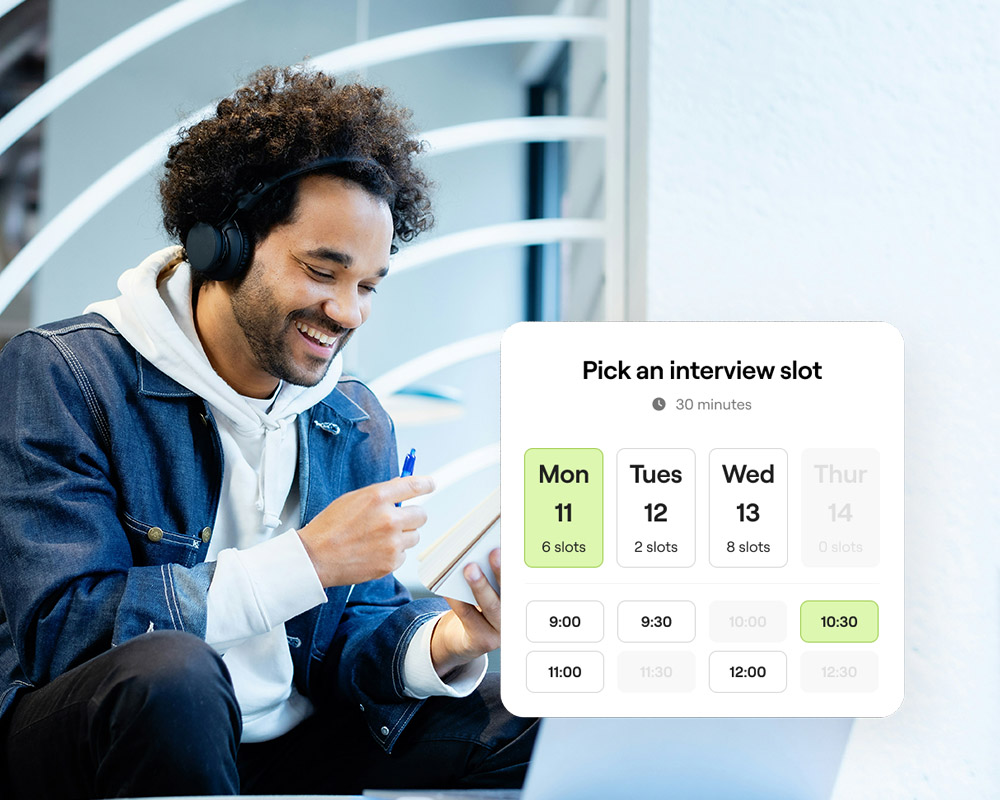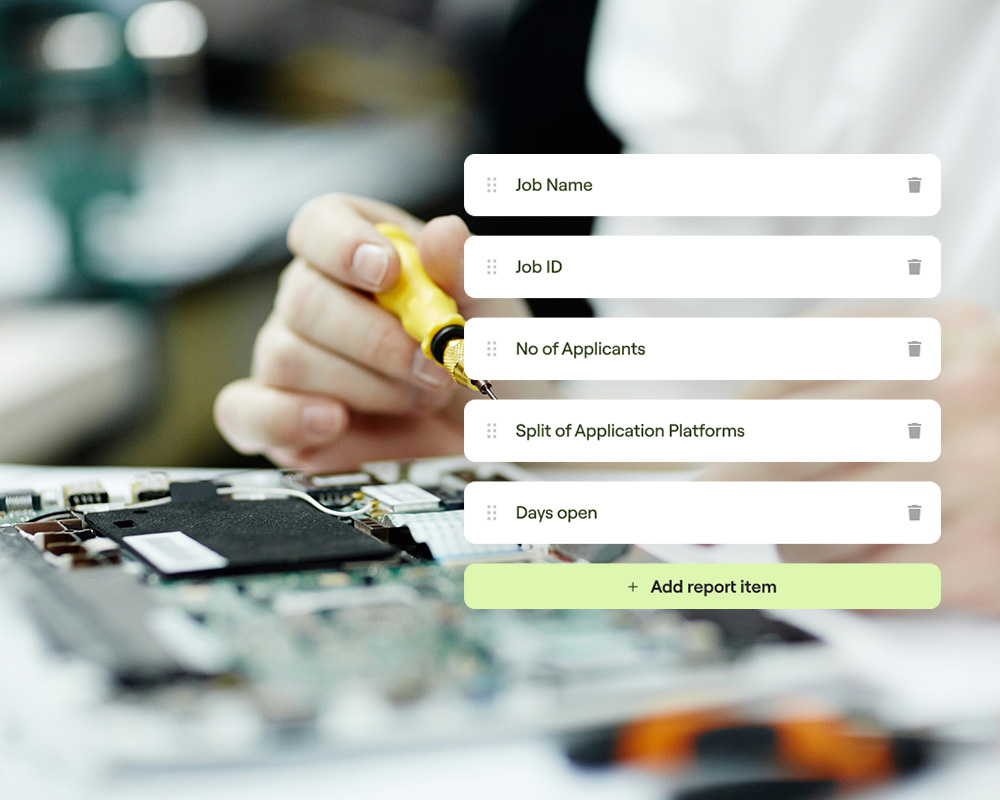We’re an acronym heavy world – and recruitment is no exception to that rule. If you’re unsure what the difference is between a CRM an ATS or an HRIS, or which recruitment technology will best suit your organisation’s needs, then read on!

Jump ahead to:
What is recruitment technology?
What are some of the main recruitment technology solutions available?
What are the typical applications of recruitment technology?
Future trends in recruitment tech
What are the challenges of recruitment technology?
How to choose the right recruitment tech for your business
What is recruitment technology?
Recruitment technology is the term for any digital tools, platforms or software systems that help organisations hire talent in an efficient manner.
Designed to streamline and refine the hiring process, recruitment technology speeds up hiring by automating certain hiring tasks.

What are some of the main recruitment technology solutions available?
There’s a wealth of digital software that can help HR teams with their hiring – here’s some of the most well-used systems:
ATS – Applicant Tracking System
This specialist recruitment software allows HR teams to manage the recruitment process from requisition to onboarding. The system tracks candidate progress automates communications and offers a variety of specialist features to enhance hiring workflows.
CRM – Customer Relationship Management system
While better known as a tool for managing customer/client relationships for sales and marketing purposes, CRM systems are also sometimes used for hiring tasks. They can be used to build talent pools and are great for organising and segmenting contacts. However, they lack crucial recruiting features such as job posting, shortlisting and hiring workflow automation.
HRIS – Human Resources Information System
HRIS software helps companies manage and automate core HR functions such as employee data, payroll, benefits and attendance. Some HRIS include basic ATS features for talent acquisition.
Screening tools
An umbrella term for any software that streamlines the evaluation and filtering of candidates in the recruitment cycle. It encompasses skills assessment tools, psychometric testing tools and background checking software (e.g., DBS and Right to Work checks.)
Most companies will choose a dedicated ATS for their recruitment process – it offers more specialist tools than an HRIS and (a good quality ATS) will effortlessly integrate with screening tools, HRIS/payroll systems and of course remote interview software, for a seamless user experience.

What are the typical applications of recruitment technology?
In an increasingly competitive and candidate-driven marketplace, an agile and responsive hiring process is crucial. Recruitment technology is used to:
- Automate hiring workflow
- Automate and personalise candidate communications
- Ensure compliance (e.g., background checks, GDPR etc.,)
- Manage interview scheduling
- Shortlist applications
- Perform online interviews & skills assessments
- Send job offers and facilitate digital contract signing
- Centralise hiring documentation
- Enhance internal collaboration
- Collect and report on hiring data
Using recruitment technology is also a powerful way to reduce or mitigate bias in the hiring process. Rules-based software can shortlist applicants based on qualifications or experience alone without considering protected characteristics.
By automating these manual administrative tasks, recruitment technology, particularly ATS systems enhance consistency and compliance. Freeing up your team to focus on a more strategic and personal approach to hiring.
Future trends in recruitment tech
Recruitment technology is evolving rapidly. A lot of recruitment technology companies are now using AI powered tools in their software. AI powered tools and features are already showing huge potential to further refine and optimise hiring.
Of course, there are also ongoing discussions taking place about the ethical and legal dilemmas AI presents – a good summary of which can be found in this article covering a panel debate at a recent CIPD conference.
Ethical issues notwithstanding, we are likely to see a far more widespread use of AI and machine-based learning for recruitment, which will lead to:

Hyper-automation
AI powered features will be increasingly used for sourcing, screening and assessing candidates, they may even be used to make hiring decisions for high-volume recruitment.
Hyper-personalisation
Way beyond the current ‘personalisation’ of emails, AI will enable recruitment software to produce even more individualised communications for candidates based on their skills, past projects and previous interactions with the organisation. Providing ever more sophisticated candidate engagement.
Immersive and interactive candidate experiences
The adoption of more immersive recruitment technology might well see HR recruitment techniques include virtual careers fairs. Gamification will also be used to provide more in depth, nuanced and user-friendly skills assessments.
Skills-based candidate tracking
With a growing focus on a skills-based economy, Advanced AI tools will be able to skills-match individuals with roles, regardless of their previous job titles, providing a much broader talent sourcing pool. Additionally, organisations might use recruitment technology to continuously track employee skills for more internal mobility.
Ethical and Transparent Hiring for Candidates
AI tools are already being used to detect and mitigate recruitment bias. As these features are more widely used, there will be a move towards a more transparent use of AI, with a growing emphasis on candidate privacy and individual control over how their personal data is being used.

Proactive talent pipelining
Increasingly sophisticated data analytics will allow organisations to identify and engage with potential talent long before a specific role becomes vacant. Skills-based talent pools powered by AI will anticipate and fill vacancies faster, reducing advertising spend and preventing ‘gaps’ in teams whilst waiting for roles to be filled.
What are the challenges of recruitment technology?
Recruitment technology can really expedite hiring, gaining teams huge efficiencies – but of course, these tools come with their challenges too. It’s not just about having a digital hiring platform it’s about having the right one…
If your smart hiring software doesn’t integrate with your existing technology, your payroll or external assessment, then you’ll quickly find you’ve only increased the amount of work your team needs to do. True efficiency only comes with a fully integrated system.
Overly complex tools can also become an obstacle to success. If the software you choose isn’t intuitive and user friendly, your HR team (and let’s not forget the non-hiring colleagues involved in recruitment across the business) simply won’t use them. Find a system that everyone is happy to use, or it will quickly become redundant.
The same goes for data; all the hiring data in the world is useless if you can’t configure your tech to report it in a way that’s useful to you.
And finally, whilst an excellent ATS will automate your workflows from requisition to onboarding, it’s nothing without human expertise. Your hiring team knows your organisation and people in a way your tech never will. Technology is here to enhance hiring, not replace your HR team.
How to choose the right recruitment tech for your business
It doesn’t matter if you’re a small start-up or a multi-national corporation – there’s hiring software out there for you. For most companies, this is an ATS. This dedicated hiring platform was designed solely for recruitment workflows and a well-designed system will handle all your hiring needs from posting to job boards right through to contract signing.
Those making their first foray into recruitment technology might consider an HRIS as the best first step as a general hiring tool that also manages payroll and employee data. If you’re still unsure about whether you need an HRIS or an ATS you can read our in-depth comparison of ATS and HRIS software here.
Whether you’re looking at updating your current hiring tech, or taking your first step into the world of recruitment software then here’s a few things to bear in mind:
Flexible fit. First and foremost, look for a system or platform that works the way you work, not vice versa. Good software can be customised to suit your workflows. Excellent software will be built to your organisation’s specifications and easily adapt to different hiring workflows. No one wants to shoehorn their recruitment process into another that doesn’t quite fit.
Try before you buy. Always ask for a demonstration of the software. Good recruitment technology companies will be happy to let you test out their systems yourself. View and try as many systems as you can – this is not only about the software, but also about getting to know the recruitment tech company too – how well will this company support your ongoing needs?
Scalability. Will the software grow and adapt with your hiring needs. For some this might mean the ebb and flow of seasonal hiring or graduate intake, for others this might be the overall growth of the organisation. Think users too – is there a limit to the number of licences for the software or is it open ended?
Personalisation. How customisable is the tech? Are there ways to shorten the hiring workflows or add in additional interview rounds? Does it allow bulk actions for those hiring at scale?
Updates and support. Once you purchase the software will there be any updates? Always consider lifespan. Tech evolves fast so you need to know it will continue to integrate with new software too. Consider the support package provided – will you be able to speak directly to the customer support team, how responsive are they? Don’t forget to ask about how much training is provided.
Usability. The system you choose must be user friendly. Most hiring platforms are collaborative tools, and if you can’t get the entire hiring team on board because the system is too finicky to use, then you’ll end up circumventing it. A system that is simple and intuitive will always be used.
Data and Analytics. As well as streamlining the way you work, improving the candidate experience and enhancing internal collaboration, recruitment technology is a rich source of data. Tools with advanced analytics and custom reporting will empower your team to continuously improve and refine your hiring.

Reach for More Human Hiring
So, there you have it. A whistlestop tour of recruitment technology and the ways it might benefit your organisation and enhance your candidate experience.
There are some great hiring solutions available for organisations of all shapes and sizes; and the best will always adjust to fit not only your company’s specific needs, but also the latest recruitment techniques.
But don’t overlook the most critical aspect of hiring – humans. Good hiring software will enhance your candidate experience, increase internal collaboration and free up your hiring team to do what they do best, find the right people for your organisation.
Great hiring software (like Reach ATS) will also provide a friendly, responsive and accessible customer support service too. At Reach ATS we’re focused on putting the human back into HR. So, if you’d like to speak to one of our own wonderful humans about our expert candidate attraction team, superior job board knowledge and brilliant bespoke ATS system, then Reach out and book a demo today.
